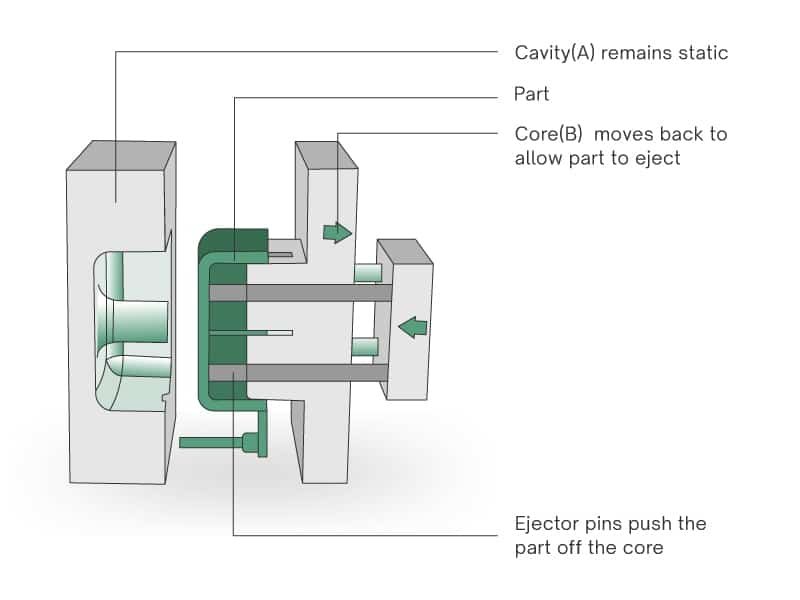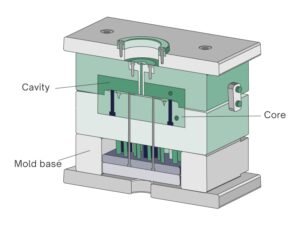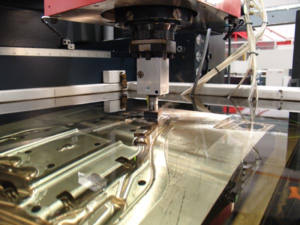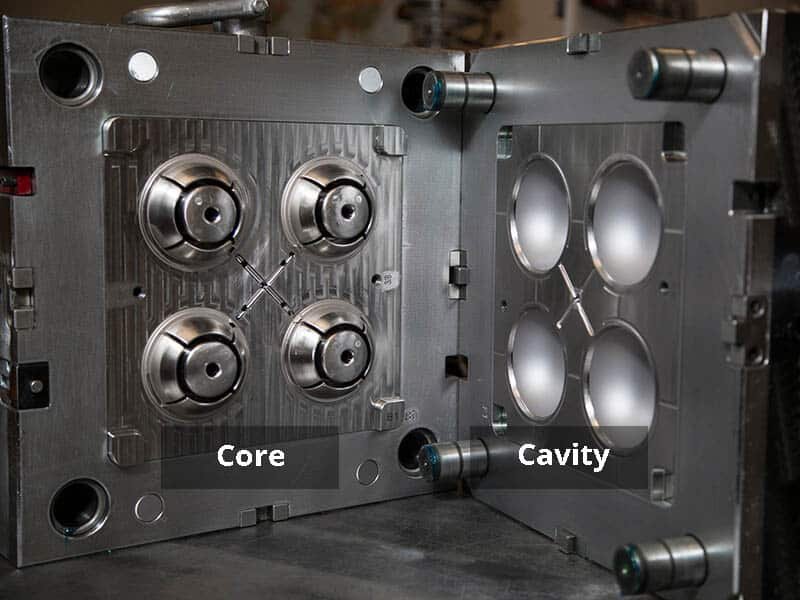The core and cavity in injection molding are essential elements that define the shape, structure, and functionality of molded parts. Understanding how these two components work together is crucial for optimizing mold design and ensuring precise production outcomes. This article delves into the intricate roles of the core and cavity, exploring their definitions, key differences, design considerations, and the calculations involved in determining their sizes and depths.
Understanding Core and Cavity in Injection Molding
Injection molding core and cavity are two halves of a mold that form the negative and positive spaces of the product being manufactured. The cavity typically represents the hollow portion where molten material is injected, while the core fills the opposing side, providing a complementary shape.

Together, the core and cavity determine the external and internal features of the molded part. As the molten plastic enters the cavity, it takes the shape of the surrounding surfaces. The core ensures that internal geometries, such as hollow sections or protrusions, are accurately formed.
Relationship Between Core, Cavity, and Mold Base
The mold base serves as the structural housing that holds the core and cavity in place. This assembly ensures stability during the injection molding process, maintaining alignment and allowing the mold to open and close seamlessly. Without precise coordination between the mold base, core, and cavity, achieving high-quality parts would be impossible.
Despite from core, cavity and mold base, learn the other critical components of injection mold.

Key Differences Between Core and Cavity
Location in the Mold
The core is generally positioned on the moving side of the mold (ejector side), while the cavity resides on the stationary side (injection side). This arrangement facilitates the ejection of the molded part, as the core retracts with the mold opening.
Functionality in Molding
The cavity defines the exterior features of the molded part, while the core shapes the internal features. For instance, the cavity forms the outer contours of a bottle, while the core creates its hollow interior.
Impact on Part Design
Core and cavity design significantly impact the structural integrity and surface finish of the part. Factors like draft angles, wall thickness, and material flow depend on their precise engineering. Misalignment or poor design can result in defects such as warping, sink marks, or incomplete filling.
Core and Cavity Design Considerations
Material Selection
The materials used for core and cavity construction play a pivotal role in the mold’s performance and durability. Commonly, hardened tool steels such as H13 or P20 are preferred for their strength, wear resistance, and ability to withstand high injection pressures. For less demanding applications, aluminum or beryllium-copper alloys may be used to balance cost and thermal conductivity.
Selection considerations include factors like the type of plastic being molded, expected production volume, and desired part quality. For instance, abrasive or glass-filled polymers require tougher materials to prevent premature wear.
Cooling Channels and Thermal Management
Effective thermal management is vital in ensuring consistent part quality and reducing cycle times. Cooling channels embedded within the core and cavity facilitate uniform heat dissipation during the molding process. Poorly designed cooling systems can lead to warping, uneven shrinkage, or extended cooling times, negatively impacting production efficiency.
Strategic placement of cooling channels and the use of high-conductivity materials enhance thermal regulation, maintaining optimal mold temperatures throughout the process.
Draft Angles and Surface Finishes
Draft angles are slight tapers applied to the core and cavity surfaces to facilitate the easy ejection of the part. Without proper draft angles, parts may stick to the mold, causing damage or deformation. The degree of draft required depends on factors such as part geometry and surface texture.
Surface finishes also influence part aesthetics and functionality. A polished cavity surface may be necessary for products requiring a glossy appearance, while textured finishes can enhance grip or conceal imperfections.
Core and Cavity Placement in Mold Design
The placement of the core and cavity within the mold impacts material flow, cooling efficiency, and part ejection. Designers must consider factors such as gate location, runner system design, and part orientation to minimize defects and ensure seamless mold operation. Misplaced cores or cavities can result in material flow imbalances, leading to weld lines, voids, or uneven filling.
Challenges in Core and Cavity Design
Complex Geometries
Modern products often feature intricate shapes and fine details, making core and cavity design increasingly complex. Creating molds for such geometries requires advanced machining techniques, precise tolerances, and sometimes even multi-part assemblies to achieve the desired features.
Maintaining Mold Integrity During High-Volume Production
High-volume production demands molds that can endure repeated cycles without compromising part quality. Wear and tear from repeated injection pressures, thermal cycling, and material abrasion can degrade the core and cavity over time. Using robust materials and implementing periodic maintenance schedules help sustain mold performance.
Minimizing Defects in Injection Molded Parts
Defects such as flash, warping, sink marks, or short shots can arise from poorly designed cores and cavities. Addressing these issues requires meticulous attention to mold alignment, material flow, and cooling. Incorporating simulation tools during the design phase can help predict and mitigate potential defects, ensuring flawless part production.
Core and Cavity Manufacturing Processes
CNC Machining and EDM for High-Precision Mold Components
CNC (Computer Numerical Control) machining and EDM (Electrical Discharge Machining) are essential techniques for producing high-precision core and cavity components. CNC machining excels in creating intricate designs with tight tolerances using advanced programming to execute complex cuts and contours. Materials such as hardened steel and aluminum are commonly used due to their machinability and durability.

EDM is particularly valuable for forming detailed features like sharp corners or narrow slots that are challenging to achieve with traditional machining. This process uses electrical discharges to erode material, offering unmatched precision for complex geometries and fine finishes.

Casting Techniques for Large and Complex Mold Parts
For larger or less intricate mold components, casting is a cost-effective alternative. Materials such as cast iron or aluminum alloys are poured into molds to create the desired shape. After cooling, the cast components are often machined further to achieve the necessary precision. Casting is ideal for producing cores and cavities with robust structural integrity and smooth surfaces, particularly when size or complexity would make machining alone impractical.
Quality Inspection and Maintenance of Core and Cavity
Dimensional Accuracy
Dimensional accuracy is critical to ensure that the core and cavity meet design specifications. Precision measurement tools such as CMMs (Coordinate Measuring Machines) are used to verify dimensions, tolerances, and alignment. Any deviations can result in defective parts, making this step indispensable for maintaining mold quality.
Surface Integrity
Surface integrity inspections focus on identifying defects like scratches, pitting, or uneven finishes that could affect the molded part’s appearance or functionality. Techniques like optical scanning or surface profilometry provide detailed assessments, ensuring that the core and cavity surfaces meet stringent requirements.
Testing Fit and Function
Testing the fit and function of core and cavity components ensures seamless assembly and operation during the injection molding process. Trial runs with prototype molds can identify issues with part ejection, cooling efficiency, or material flow, allowing for timely corrections before full-scale production.
Maintenance and Repair of Core and Cavity Components
Regular maintenance is essential for prolonging the life of core and cavity components. Preventive measures such as cleaning, polishing, and lubrication help reduce wear and tear. In cases of damage or excessive wear, repairs such as re-machining or surface treatment can restore functionality. A well-maintained mold minimizes downtime, enhances production efficiency, and ensures consistent part quality.
Conclusion
The core and cavity are fundamental to the injection molding process, shaping every aspect of part design, functionality, and production efficiency. From material selection to manufacturing techniques and quality maintenance, each step in the lifecycle of these mold components is vital for achieving precision and reliability.
By understanding the intricacies of core and cavity design, manufacturing, and maintenance, manufacturers can optimize their injection molding operations, ensuring high-quality parts and prolonged mold life.
FAQs
The core and cavity in injection molding serve as the two primary elements that define the shape and structure of a molded part. The core is the internal part of the mold that creates the hollow sections of the part, while the cavity forms the exterior shape. Together, they ensure that the material injected into the mold takes the desired form, allowing the production of complex and precise parts.
The choice of material for mold cores and cavities depends on factors such as part complexity, material flow, and production volume. Common materials include high-carbon steel for durability and strength, aluminum for its lightweight nature and fast heat dissipation, and tool steels like H13 for high-temperature resistance. In some cases, beryllium copper is used for its excellent thermal conductivity.
Cooling is crucial for maintaining the desired mold temperature and ensuring the final part is properly formed. The efficiency of the cooling system impacts cycle times, part quality, and mold longevity. Proper cooling helps in minimizing warping, defects, and uneven material flow. It also prevents overheating, which can cause the core and cavity to degrade over time, leading to costly repairs.
In an injection molding tool, the core is the part of the mold that creates the internal geometry of the part, such as hollow sections, while the cavity is the external counterpart that defines the outer shape of the part. The core is typically inserted into the cavity, with molten material injected into the cavity, around the core, to form the part.






